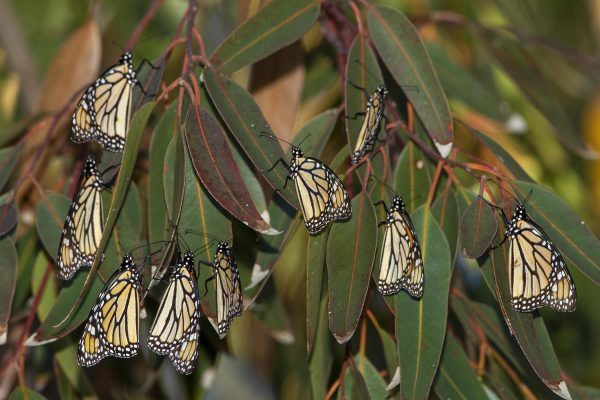
Annual butterfly count sees early upswing, raising more questions
Bluebird Canyon resident Janet Chance watched as the long, swollen belly flipped out of the chrysalis and two wet wings started to awkwardly unfold.
She wasn’t sure if things were happening as they should. Thin black legs were groping for any edge they could grasp on the split chrysalis. She watched as the polka-dotted belly began pumping out its fluid to inflate the folded wings, and they grew bigger. Within seconds, the wings stretched and straightened in the warm sun and a freshly morphed western monarch butterfly took its full shape.
“Then suddenly, it soared into this clear, blue sky,” she said. “It was the most magical moment, and to actually see it. It is truly a moment I will never forget.”
A local team of scientists and monarch butterfly monitors were scheduled early this morning to count overwintering monarchs at traditional sites, including San Clemente and Doheny state beaches, as part of California’s 25th annual western monarch butterfly count.
The count this year is critically important because monarch butterflies are on the brink of extinction in California. The striking orange, black and white-polka-dotted winged insects are the only butterfly that migrates like birds do because they cannot survive cold, northern and mountain winters.
This year’s Thanksgiving count started on Nov. 13. Monitoring teams are locating and counting clusters of closed-winged monarchs hanging like fall leaves mostly in eucalyptus trees. Official counts will be finalized on Dec. 5 at westernmonarchcount.org by the Xerces Society for Invertebrate Conservation in Portland, Ore.
Counts were down to 2,000 last year from the millions of monarchs that overwintered here from colder Rocky mountain climates in the 1980s, according to Xerces data. Hundreds of thousands still roosted in California’s Monterey pine and cypress groves and eucalyptus trees from the 1990s to 2017. Last year’s statewide count was an unprecedented low, especially compared to the two previous years, which themselves saw unparalleled drops of less than 30,000 butterflies.
Counts from the past three years concern scientists because 30,000 monarchs is considered the lowest point before impending migration collapse, reported Xerces.
Chance, a retired physician and vice president of the Laguna Beach Garden Club, was lucky enough to be sitting on her front deck reading a book when the pupa came of age. But it wasn’t by chance.
Last February, she removed invasive iceplant from her property and planted, by herself, an array of local native plants, including the thin-leafed native milkweed. Native milkweed is a keystone food source for monarch larva. Several monarch caterpillars, as striking as their adult counterparts, were soon spotted around her garden. She found that if you plant it, even in a pot, they will come.
Bob Allen, biology professor and regional coordinator of the Orange County monarch butterfly count, has counted monarchs since 1970. The height of the winter monarch butterfly migration from the Rocky Mountains to the California coast occurred in the late ‘60s and early ‘70s in what was then wild habitat. “But, unfortunately, some of the larger sites have been developed,” Allen said. The largest layover was in San Juan Capistrano, now a golf course and gated community.
Habitat loss due to suburban development and landscaping, parasitic disease, warmer temperatures, pesticide poisoning and fast-moving vehicles is a risk monarchs are increasingly facing. With no specific cause for decline yet identified, as of Nov. 12, early statewide sightings were encouraging. At least 50,000 monarchs were surveyed at traditional overwintering sites. But 50,000 is still a far cry from the millions in past decades.
“The numbers severely crashed in the early 2000s so it’s been about 20 years of crash in the whole state and Orange County, most certainly,” said Allen, locally known as Bug Bob and co-author of “Wildflowers of Orange County and the Santa Ana Mountains.”
An early survey was taken by one of Allen’s team members, Ron Vanderhoff, general manager and vice president of Roger’s Gardens in Newport Beach. Vanderhoff found a cluster of 200 in a Monterey cypress tree on private property in San Clemente a month ago.
“Depending upon counts elsewhere, this colony could significantly improve our OC numbers,” Vanderhoff said. “In fact, this could become the new largest overwintering colony in the county, fingers crossed.”
Last week, that cluster was nowhere to be found. Vanderhoff made an early Thanksgiving count that turned up only 36 of the majestic winged insects roosting at Doheny and San Clemente state beaches.
A top concern of scientists is the pervasive use of pesticides, particularly the crop insecticide known as neonicotinoids. “Neonics” poison nectar-seeking butterflies and specialist pollinators such as native bees and bumble bees.
Even though there’s no hard data to back up the pesticide hypothesis, Allen proffered a caveat. “Here’s the thing: a whole new class of insecticides was released right before the time the monarchs started crashing,” he said. That new class was neonicotinoids.
“Their use worldwide just exploded,” he continued. “It’s quite a coincidence that the monarch crash coincides with the widespread use of that pesticide.” Chemical analysis would prove the theory but, Allen said, it’s expensive, tedious “and we have to kill the butterfly.”
“Pesticides are a major threat to insects,” said Hillary Sardinas, pollinator coordinator for the California Dept. of Fish and Wildlife. Pesticides are now being found in native plants in wilderness areas, particularly in milkweed, she said.
“It can affect how many offspring they produce,” Sardinas said. “It can affect their navigational abilities and it can, of course, lead to death.”
Although insect populations tend to fluctuate, depending on available food sources and weather conditions, the early increase of migratory western monarchs this year is not considered a recovery. Scientists say it could be due to fair traveling weather, cooler fall temperatures than last year and a good deal of luck.
A somewhat more optimistic hypothesis is that warmer temperatures are keeping monarchs from migrating to the California coast.
“When it’s a warm winter, a lot of the western monarchs, that’s the ones this side of the Rockies, don’t bother migrating here because the weather is so nice where they’re already at,” Allen said. “Why should they congregate for warmth in a place that’s a long way away?”
On the down side, scientists conjecture that monarch butterflies are now breeding year-round because they’re feeding on tropical milkweed instead of the native milkweed, said Emma Pelton, senior conservation biologist with Xerces. A protozoan parasite that lives in the leaves of resilient tropical milkweed acts like a toxin, reducing the butterfly’s lifespan as well as its ability to migrate and reproduce.
Early numbers might be high because monarchs don’t have the strength to migrate and are more sedentary, which leads to higher rates of disease, according to a Xerces report.
Once Chance switched to a more drought-tolerant garden, she also notice it was a livelier habitat. Native plants have evolved to thrive in those conditions. She’s beginning to realize that planting native plants, particularly food plants for caterpillars, is reviving a local ecosystem that provides a life-support system for people: clean water, clean air and food for pollinators that pollinate food that feeds us.
“You know what I love about them, all these plants? Whenever I go out in the garden and there’s the least little breeze, everything moves and flutters,” Chance said. “You suddenly realize all the insects are coming, all the birds are coming. It’s low maintenance and incredibly tranquil.”
The long-time Lagunan will soon transition into the two-year position as president of the Garden Club. At the top of her list: offering more public talks from experts on the benefits as well as the seriousness of planting natives.




